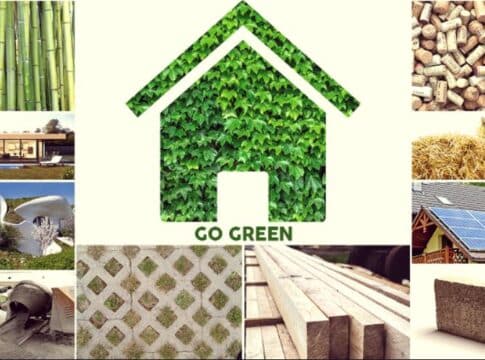Carbon Negative Building Materials
Perhaps you’re wondering if carbon negative building materials can indeed absorb more carbon than their production emits. If you do, then you’re not alone, many of us do.
In fact, a lot of people have the same question in mind… And it’s not surprising because carbon negative building systems are quite recent but it’s here to stay. Why?
Over a third of worldwide greenhouse gas (GHG) emissions are courtesy of the building sector. And the world is at the critical point when it has to reduce GHG emissions. That’s why.
What is Carbon Sink Building Material Emissions?
First up, it helps to differentiate between carbon neutral and carbon negative.
Being carbon neutral means the amount of CO2 the material emits is the same as the amount it removes from the atmosphere. Being carbon negative means the amount of CO2 the product sucks in is more than it releases.
Carbon negative building systems involve the use of construction materials and technology that can slash the carbon emissions of the building sector with effective removal of CO2 from the air. This is possible with the application of a combination of these:
Sustainable energy sources
Energy-efficient engineering
Carbon capture technology
Building Sector: A Major Source of Carbon
Carbon emissions from the building industry and its impact on the environment are getting traction recently. The building sector accounts for a large amount of energy use and carbon emissions.
The building industry is responsible for about 39% of the global GHG emissions.
There are simply a lot of sources of GHG when building a structure, such as from sulfur dioxide, carbon monoxide, carbon, particulate matter, and other pollutants. Other major sources include the energy needed for the production and transportation of building materials, treatment, dumping of wastes, and demand for construction equipment.
Materials and products used in a building like steel and aluminum are created through various processes. These include raw material extraction, raw material process, melting, manufacture of final products, and transportation to building sites. Each of those processes uses energy expressed in carbon emissions.
Total emissions of all building materials and products and the construction involved in putting them together refer to the building’s embodied carbon. Embodied carbon accounts for about 20% of the total GHG emissions from the building sector.
Cutting embodied carbon is one of the practical mitigation measures for the sector. And it can do that by opting for carbon sink and carbon negative building materials and products.
Unfortunately, the traditional building systems don’t use carbon sink building material.
Traditional construction technologies largely rely on fossil fuels for their energy needs, which results in huge carbon emissions. Add to this the fact that these traditional systems often lack energy efficient approaches. This then led to more energy use and higher costs.
Plus, traditional building systems don’t have the ability to remove carbon from the environment. Even if emissions are cut during construction, the carbon emitted by the building itself will remain positive.
Importance of Carbon Negative Building Materials
Keeping the global temperatures at bay is no longer a choice; it’s a must. Otherwise the planet will have to experience worse effects of climate change.
This is where the significance of shifting to carbon negative building materials kicks in. Aside from their sustainability, they also offer massive financial advantages.
For instance, using renewable power sources and energy-efficient engineering may result in lower energy expenses both for builders and tenants. More remarkably but effortlessly, the carbon sequestration ability of the modern carbon negative building materials can generate carbon credits.
Carbon credits are units earned by reducing or removing carbon from the atmosphere. Each credit represents one tonne of carbon prevented or removed.
Generating carbon credits gave the holders additional income by selling the credits.
Now you might be asking what building material has the lowest carbon footprint to get the most credits?
It actually depends on how the material or product is processed, what’s the technology behind it, energy use, raw materials used, and so on. Remember the embodied carbon.
Concrete is cheap and easy to make, making it a favorite material in the building sector around the world. But that comes at the expense of the earth’s health – 7% of global carbon emissions.
At least 30 billion metric tons of concrete are used every year to erect buildings.
That fact spurs a race among scientists and engineers to design more sustainable building materials. Apart from carbon negative or green concrete, what are other examples of low carbon building materials?
Let’s get to know them all.
Types of Carbon Negative Building Materials
Research and development in low carbon building materials resulted in innovative products using recycled products. Here are some examples of recently developed carbon negative building materials.
Recycled metals:
Processes involved in producing metals are very carbon intensive. But taking their entire life cycle performance can cut their total energy use. That’s because repeated use of recycled metals doesn’t affect their properties.
Also, reusing existing metal structural parts like steel columns and beams is possible, even without the full recycling process. It’s even more interesting to know that builders can use metal products that are not meant for building. For instance, shipping containers can also be reused in building new structures.
Low-carbon bricks:
Using 40% fly ash – fine glass powder made primarily of iron, silica, and alumina – helps cut embodied carbon in conventional bricks. It’s a byproduct of burning coal for electricity generation. The use of this low carbon building material has been since 2009.
Green tiles:
What makes tiles green is the use of ceramics from ~50% recycled glass and other minerals. The waste glass turned into tiles are then used in internal and external flooring and cladding. The sparkling glass components add more aesthetic quality to the tiles.
Structural timber:
Wood is made of ~50% carbon by dry weight. Considering the embodied carbon and the stored carbon in wood, many timber building materials are carbon negative.
Thanks to its carbon negative properties, timber is making a great comeback as a popular construction material. Unlike concrete and metal made from carbon-intensive fossil fuels, timber is a renewable material that helps remove CO2 from the atmosphere.
Hempcrete:
Another carbon negative construction material is hempcrete, which is rather unpopular. It’s a composite of hemp fibers and is a glue-like binder. Hemp can suck up twice as much carbon as a typical forest.
Green or carbon negative concrete:
Byproducts of industrial processes and recycled materials used to replace raw materials to make traditional concrete. For example, fly ash and granulated blast-furnace slag are substituted for carbon intensive cement.
Likewise, washed copper slag can be used in place of aggregate or sand. Using recycled granite from demolished debris also helps reduce emissions of concrete.
How is carbon negative concrete made?
There are several ways to make low-carbon or even carbon negative concrete blocks.
One way is by adding a biogenic limestone, a carbon neutral material, which can pull CO2 from the air, making it carbon negative.
Another way is to replace traditional mix of cement with a magnesium-based cement using seawater. It can soak up carbon instead of emitting it like conventional cement do.
The manufacture of cement, concrete’s key ingredient, accounts for a whopping 8% of the world’s total emissions. But it’s not possible to stop using concrete blocks to build structures.
So, innovative ways emerge to make concrete not only a carbon neutral building material but is carbon negative, too. After all, we need stronger houses to withstand much stronger storms and hurricanes.
With all those options, what would be the best carbon neutral building materials? To help you decide or just start your selection process, we’re giving you the top products in the sector.
The Best Carbon Negative Building Materials
While there are quite a few pioneering companies trying to make a name in the space, here are the best ones that stand out.
Plantd Structural Panels
At the top of our list for the best carbon negative construction materials is the products by Plantd. Plantd is a revolutionary sustainable building materials company that transforms fast-growing perennial grass into durable, carbon negative building materials.
Plantd’s patented low-carbon emissions production technology recently attracted $10 million in Series A funding round recently. The American Family Ventures led the round.
Both the firm’s co-founders and engineers – Huade Tan and Nathan Silvernail, worked together and honed their skills at SpaceX. While there, they’ve been designing and building key systems and components of the crew spacecraft for years. Completing their pioneering team is serial entrepreneur Josh Dorfman, co-founder and CEO.
With its highly capable team, Plantd is redefining the value chain for sustainable, carbon negative building materials.
Starting with structural panel products for walls and roofs like in the picture above, Plantd will make building materials that are a direct substitute for traditional home building products. They also don’t need any alternative installation techniques.
The company grows fast-growing perennial grass instead of cutting down trees and pioneers novel production technology to reduce carbon emissions. The resulting product called Plantd Structural Panels is capable of retaining 80% of CO2 captured in the field.
That CO2 is then locked away inside the walls and roofs of new homes.
CarbiCrete CMUs
Same with Plantd’s carbon negative building materials, CarbiCrete develops innovative, low-cost building products that help reduce emissions. Its patented technology enables the production of cement-free, carbon negative concrete using mineral waste and CO2 as raw materials.
The company offers high-quality precast concrete at a lower-cost and in a way that reduces their carbon footprint. This attracts attention from investors, allowing the firm to raise a total of ~$28M to date. Led investors include NGen, Canada’s Advanced Manufacturing Supercluster.
With cement-based concrete, the first step of the process involves mixing cement with aggregate and water. With CarbiCrete, cement is out of the equation. Steel slag is used instead and is mixed with the other building materials.
It’s also worth noting that creating CarbiCrete’s CMUs (concrete masonry units) involves a specialized absorption chamber into which CO2 is injected. Within 24 hours, the concrete will reach its full-strength.
In comparison with cement-based CMUs, CarbiCrete CMUs show equivalent or better mechanical and durability properties. They also have the same water absorption properties, but have higher compressive strength by up to 30% and display better freeze/thaw resistance.
CarbiCrete’s 3rd-party Lifecycle Analysis (LCA) shows a 100% reduction of the CO2 emissions from eliminating cement use.
The result?
3kg of CO2 removed per CMU 2kg avoided by not using cement + 1kg captured during curing. In other words, net negative emissions with the permanent sequestration of carbon mineralized in the product curing.
GreenJams Agrocrete
If cement were considered a country, it would be the world’s 3rd-largest carbon emitter. It even surpassed a big country like India.
But a social enterprise, GreenJams, based in Roorkee and Visakhapatnam offers a solution. The startup gets financial support through grants by various institutions, including universities. It has completed its angel round in an undisclosed amount.
GreenJams creates carbon negative building materials from agriculture biomass and hemp blocks. Their early prototype products look like below.
Its product called Agrocrete is made from up-cycled material. Its founders said the product can:
cut construction costs by 50%,
increase thermal insulation by 50%, and
reduce the time needed to construct buildings.
The agricultural residues such as paddy straw, cotton stalks, bagasse, etc. used to make Agrocrete gets mixed with the firm’s innovative product BINDR. It’s a 100% up-cycled low carbon alternative to Portland cement made from industrial by-products of steel, paper and power industries. Here’s how Agrocrete’s life goes about.
Agrocrete has the strength the same to that of a conventional red brick from the kiln. Yet, it offers less water absorption tendency, captures tonnes of CO2 emissions and can stay for at least 75 years.
To top it all, Agrocrete blocks are 30% lighter so it also cuts labor cost and is more convenient for masons to work on.
Carbon negative building materials like the top ones above actually reduce GHG emissions as they are used. Over the course of their entire life cycle, they will remove more carbon from the air than they will release. They can help offset the environmental impact of your construction project or help make your home more sustainable.
The post Carbon Negative Building Materials appeared first on Carbon Credits.



